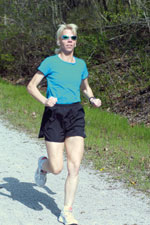Instructor recalls running in trials for ’84 Olympics

An active runner, Dr. Karen Plucinski, associate professor of anatomy and physiology, ran in the 1984 Women´s Marathon Olympic trials. A tear in her foot did not stop her from finishing. Though she no longer runs professionally, she said she finds teaching to be just as rewarding.
Although the biggest race of Dr. Karen Plucinski’s life was more than 20 years ago, she still remembers the big event.
It was 1984.
Plucinski had trained for nearly seven months for the 1984 Women’s Marathon Olympic trials, an event which could have sent her to the summer Olympics in Los Angeles. But fate wasn’t on her side that day in Olympia, Wash.
“The arch in my foot started tearing at mile 11,” Plucinski said. “I probably should have dropped out.”
But the determined and accomplished athlete, who now is an associate professor of anatomy and physiology at Missouri Southern, didn’t give up. She had plantar fasciitis, an inflammation of the right arch, but still finished the race. She eventually placed 74th.
“It was a huge disappointment,” Plucinski said. “It was very discouraging.”
Although her performance that day doesn’t rate high on her list of running accomplishments, her biggest one may have been just how she got to that race. A friend invited her to join the high school cross country team.
“She roped me into cross country,” Plucinski said. “I was an average runner.”
Before she knew it, Plucinski was going out on eight-mile runs. She enjoyed the team atmosphere and running in general so she continued practicing and she was able to run for the University of New Hampshire. During her time in school, she was averaging 50-55 miles per week.
“I knew I had to step up,” she said. “I kept up the hard training.”
She continued to blossom into a respected runner around the region. She won several regional meets and began running in longer events. Eventually, running in the national arena didn’t seem too far-fetched. At that time, however, women did not have a marathon at the Olympic level.
“Women were thought as being too fragile,” she said. “We didn’t think it was fair.”
When it was announced that the first women’s marathon would be held at the 1984 Olympics, Plucinski knew she had to go for it. She was able to land a shoe contract with New Balance.
“I was paid to run,” she said. “There was a lot of pressure.”
Besides a lot of shoes, Plucinski had a monthly stipend, private coaching and occasional bonuses to help pay for traveling expenses. At this point of time, she was running 85-100 miles per week in order to train for the race.
“You don’t just go out and run a marathon,” she said.
When the big day came, Plucinski was seeded No. 4 before the race. The foot injury that slowed down her pace considerably ended any dream of making the national team. She doesn’t know if she was healthy where she would have placed, but she said she knows she should have done better.
“I probably shouldn’t have made the team, but I should have been in the top 10,” she said.
Today Plucinski loves teaching.
She figured if running couldn’t be her full time job then she should try teaching.
She still uses her knowledge of running in her classes. That time period in her life helps her tremendously.
“Teaching is just like running,” she said. “You have to train to be a good teacher.”
Your donation will support the student journalists of Missouri Southern State University. Your contribution will allow us to purchase equipment and cover our annual website hosting costs.















